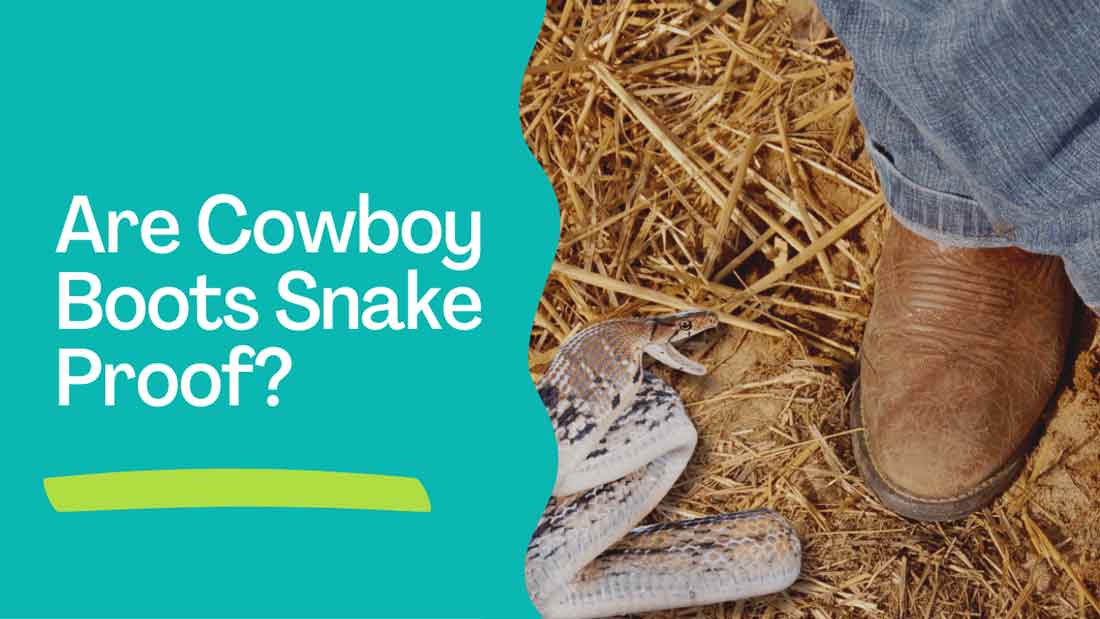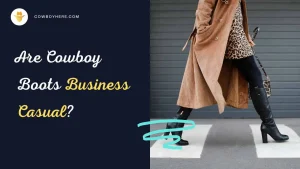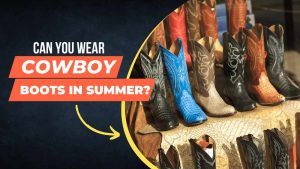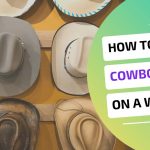Let’s delve into a fascinating query often presented by outdoor enthusiasts and Western-style aficionados – “Are cowboy boots snake proof?”
With the proliferation of cowboy boots in urban and rural settings, their potential protective properties are worth investigating, especially in regions where snake encounters are possible. This topic is not just a curiosity but a matter of safety and preparedness.
Join us as we sift through various aspects of boot design, materials, and functionality to address this intriguing question. Whether you are a hiker, rancher, or simply a fan of this iconic footwear, this investigation will be eye-opening. Stay tuned as we uncover the truth behind the myth.
Snake Strikes and Cowboy Boots: Comprehending the Mechanics of a Bite
When addressing the question, “Are cowboy boots snake-proof?” it’s essential first to comprehend snakes’ mechanics and typical behavior when they strike.
Despite popular belief, snakes don’t generally bite without cause; they typically only strike in self-defense or when hunting prey. The speed of a snake strike can be astounding, with some species able to launch their attack in under half a second.
Now let’s delve into the anatomy of the bite itself. The key players here are the fangs – specialized teeth that deliver venom.
Also read: Why are cowboy boots pointy?
Depending on the snake species, fang structure varies. Some have fixed fangs, while others have retractable ones, but all are designed to penetrate the skin and, often, underlying tissues.
The fangs act like hypodermic needles, injecting venom into the victim. They are incredibly sharp and strong, capable of piercing through various materials – including some types of clothing and footwear. Snake fangs can range in length, with the Gaboon viper boasting the longest fangs of any snake, up to 2 inches long.
However, most snakes that one might encounter have much shorter fangs. This feature is crucial when considering the potential of cowboy boots to resist a snakebite. Could the materials and design of a cowboy boot withstand the strike? We’ll consider these factors more closely as we progress in our discussion.
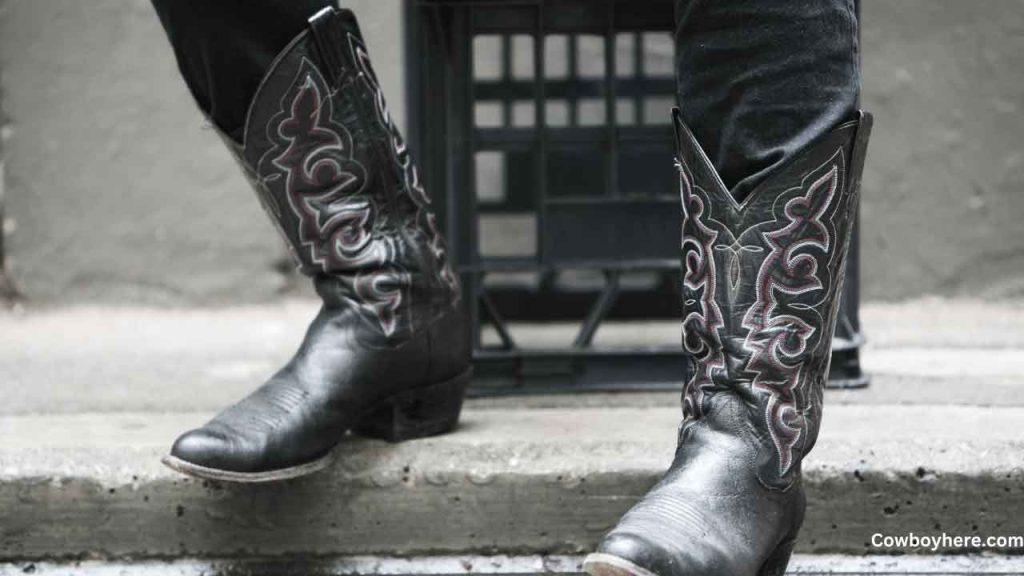
Cowboy Boots Vs. Snake Fangs: Dissecting the Boot Design
Before we delve into whether cowboy boots can hold their ground against a snakebite, it’s crucial to understand the basic anatomy of this iconic footwear. Cowboy boots have a unique structure specifically designed for life on the saddle, but they have evolved over the years into versatile shoes suitable for various settings.
A cowboy boot typically comprises four key components: the upper part, the insole, the outsole, and the heel. The upper part is usually made from a single piece of leather, often adorned with intricate stitching or embossed designs.
This part extends up the calf and is primarily responsible for protecting environmental factors. This feature is critical when considering snake strikes.
The insole and outsole provide comfort and durability. The insole is the interior bottom of a boot where your foot rests, whereas the outsole is the outer part that contacts the ground. Traditionally, these were made from tough, layered leather but can now be made from rubber or composite materials in modern boots.
The heel, usually about an inch high or more, was initially designed to keep a cowboy’s foot secure in the stirrup. This boot part is typically made of leather, often layered and nailed together for added durability.
Traditionally, cowboy boots were made primarily from cowhide leather, thanks to their robustness and availability. However, in today’s market, various materials, including exotic leathers like alligator, ostrich, snakeskin, and synthetic materials, are used for more budget-friendly options.
Each component, the materials used, and the construction process have implications for our central question: are cowboy boots snake-proof? Let’s forge ahead to address this issue directly in the next section.
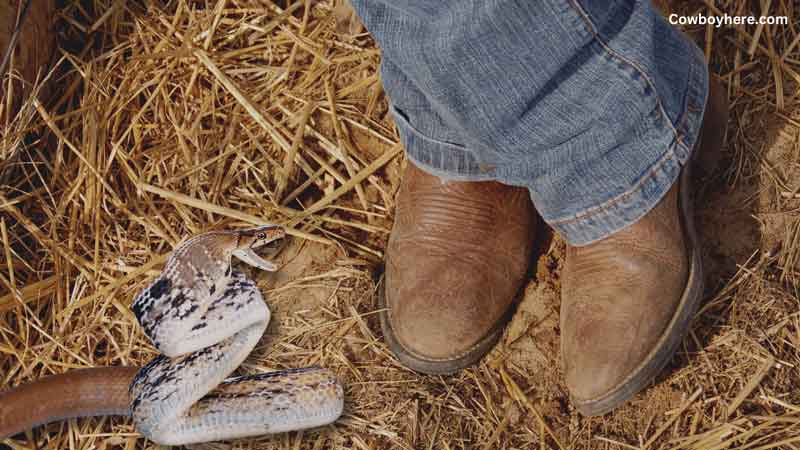
Are Cowboy Boots Snake Proof?
As we now understand the potential force of snakebite and the anatomy of a cowboy boot, we can address the burning question, “Are cowboy boots snake-proof?” As it often is with such matters, the answer is more complex.
By their design and traditional construction, Cowboy boots offer a degree of protection superior to many other common types of footwear. The rugged leather used in crafting the upper part of the boot is challenging for most snake fangs to penetrate. This is especially true for the thick, robust leather that high-quality cowboy boots are known for.
However, “snake-proof” is a strong term, suggesting a guarantee against snake bites, and this is where the situation becomes murkier.
The reality is that while a cowboy boot may offer significant protection, it isn’t invincible. Certain snakes, particularly those with longer fangs or a more forceful strike, could pierce a Cowboy boot.
The ability of a snake to penetrate a boot also depends on the specific circumstances of the strike. A direct hit to the thickest part of the boot is less likely to be successful than a strike at a more vulnerable area, such as where the upper part meets the lower boot or the boot stitching.
In short, while cowboy boots provide snake bite protection and suffice in areas where venomous snakes are less common or less dangerous, they shouldn’t be relied upon as the sole means of protection in areas known for snakes with potent venom or longer fangs. The real-world encounters and stories we’ll share in the next section will further illustrate these points.
Beyond Cowboy Boots: Exploring Alternative Footwear and Snake Bite Prevention
If the possible risk associated with cowboy boots and snake bites concerns you, exploring alternatives explicitly designed with snake defense in mind might be beneficial. Snake-proof boots are one such option.
These boots are manufactured using materials tested to resist snake strikes, such as sturdy leather and synthetics, often reinforced with layers for added protection. The height of these boots usually extends to the calf to protect the lower leg, a common target of snake strikes.
When comparing snake-proof boots with cowboy boots, one key difference stands out. While both offer protection against snake bites, snake-proof boots are designed and tested to prevent fang penetration, offering more reliable security in snake-prone environments.
However, footwear is just one aspect of snake bite prevention. It’s equally important if not more so, to be aware of your surroundings. Stick to well-trodden paths with good visibility and use a flashlight when moving around at night. Avoid reaching into blind spots, such as under rocks or logs, where snakes may hide.
Wearing long, thick socks and trousers can also add a layer of protection for the areas not covered by your boots. And remember, the best way to avoid a snake bite is to give snakes a wide berth whenever encountered. Education about the types of snakes in your area, their habitats, and their behavior can also be vital in preventing snake bites.
North American Nemeses: Highlighting Dangerous Snakes with Potent Strikes
While discussing the defensive capabilities of cowboy boots, it’s worth examining some potential adversaries. In North America, there are several venomous snakes whose strong bites could challenge the protective properties of cowboy boots. Let’s explore a few of them:
- Eastern and Western Diamondback Rattlesnakes: The giant venomous snakes in North America are known for their potent venom and long fangs. The Eastern Diamondback, in particular, can reach lengths of up to 8 feet and has fangs over an inch long. A strike from one of these could potentially penetrate less sturdy footwear.
- Cottonmouth or Water Moccasin: This snake, found primarily in the southeastern United States, has a particularly potent venom. While not as large as the Diamondbacks, the Cottonmouth has a reputation for being more aggressive when threatened.
- Coral Snakes: These brightly colored snakes are less likely to strike than others, but their venom is highly potent. Their smaller fangs may struggle to penetrate thicker materials, but they shouldn’t be underestimated.
- Copperheads: Common across much of the eastern and central United States, Copperheads are responsible for many snakebite incidents each year, although their venom is less potent than some other species.
These are just a few examples of venomous snakes in North America. Remember, the best way to prevent snake bites, regardless of your footwear, is to be aware of your surroundings, know how to identify these snakes, and give them a wide berth if you encounter them.
Staying Safe: Proactive Measures to Minimize Snake Bite Risks
While footwear choices, such as cowboy boots or snake-proof boots, can protect against snake bites, it’s important to remember that prevention is the best form of protection. Here are some essential precautions to significantly reduce the risk of being bitten by a snake:
- Know Your Territory: Be aware of the types of snakes common in your area or where you will be hiking, camping, or working. Knowledge about their habits and preferred habitats can help you avoid unwanted encounters.
- Watch Your Step: Be cautious where you step, especially in areas with tall grass, underbrush, rocky terrains, and near water bodies where snakes might hide.
- Light Your Path: Use a flashlight or headlamp when walking at night, even in familiar areas, as snakes are nocturnal creatures and more active during this time.
- Keep Your Distance: If you spot a snake, keep a safe distance. Most snakes will only strike if they feel threatened or cornered.
- Appropriate Clothing: Wearing long pants, preferably made of heavy material, can offer extra protection. Combine this with boots that cover your ankles for maximum safety.
- Be Cautious When Handling Objects: When moving rocks or logs or reaching into areas out of sight, proceed with caution, as these can be ideal hiding spots for snakes.
- Keep Your Campsite Clean: If camping, keep the area clean and free from food scraps to avoid attracting rodents, which may attract snakes.
Remember, no precautionary measure provides 100% safety against snake bites, but implementing these strategies will significantly reduce your risk. Always stay vigilant and respect the wildlife around you.
Snake Bites Across the States: A Regional Perspective
The threat of snake bites is unique across the United States, with certain states reporting a significantly higher incidence than others. This variation in snake bite occurrences mainly depends on climate, natural habitats, and human activities in snake-prone areas.
According to World Animal Foundation report, over 7,000 people in the United States annually suffer from venomous snake bites. However, this risk is spread unevenly across the country. Several states stand out for their notably high rates of snake bites per million population per year.
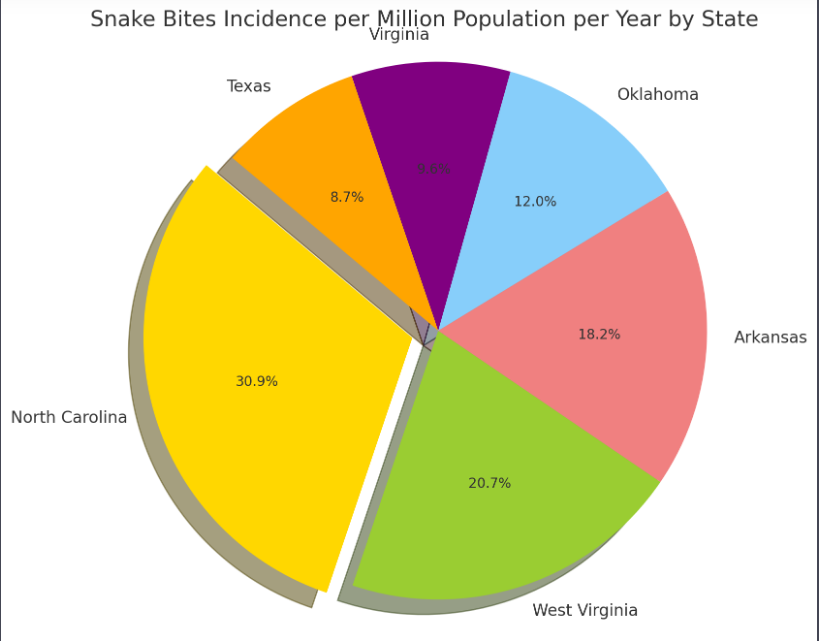
North Carolina is leading the pack, reporting a striking 157.8 snake bites per million people annually. Next in line is West Virginia, with a rate of 105.3. Arkansas follows closely behind at 92.9. Oklahoma, while lower, still reports a considerable figure at 61, while Virginia and Texas round out our list with 48.7 and 44.2 snake bites per million population per year, respectively.
These numbers underscore the importance of taking proper precautions when living in or visiting these states, especially when venturing into snake-prone areas. Awareness of the snake species common in these regions, their behaviors, and preferred habitats, as well as wearing appropriate footwear and clothing, can go a long way in minimizing the risk of a snake bite.
Conclusion:
As we’ve journeyed through the history, anatomy, and potential of cowboy boots in their battle against snake bites, it’s clear that the answer to the question, “Are cowboy boots snake proof?” is nuanced.
Yes, cowboy boots’ sturdy materials and design can offer a certain degree of protection, potentially preventing a snake’s fangs from reaching your skin. However, they are not foolproof against snake bites. Depending on the type of snake, the force and angle of the strike, and the specific construction of the boot, there is still a risk of a snake bite penetrating cowboy boots.
For those who often find themselves in snake-prone areas, especially regions inhabited by venomous species, considering specially designed snake-proof boots may offer greater peace of mind.
Regardless of your footwear, remember that the best defense against a snake bite is awareness and preventive behavior. Avoid known snake habitats when possible, be vigilant in areas where snakes could be present, and always give snakes a wide berth if you encounter them.
Cowboy boots, an iconic symbol of the American West, offer more than just a stylish statement. While they provide some protection against snake bites, they should be part of a broader strategy of caution, awareness, and respect for these remarkable reptiles.
FAQs
Q: If a snake bites my cowboy boots, will the venom harm the boots’ material?
A: No, snake venom is a complex mixture of proteins and enzymes that is harmful to biological tissues but does not typically damage materials like leather or synthetics. So, a snake bite shouldn’t harm the fabric of your boots.
Q: Can the snake venom penetrate the cowboy boot if it doesn’t puncture the material?
A: Snake venom needs to enter the bloodstream to be effective. If a snake’s fangs can’t puncture the boot’s material, the poison should not be able to penetrate the material either. Therefore, it won’t reach your skin or enter your bloodstream.
Q: I own a pair of cowboy boots made of snakeskin. Are these more or less snake-proof than traditional leather boots?
A: Snakeskin boots are more about fashion and less about practicality when protecting against snake bites. At the same time, snakeskin is challenging but less thick or sturdy than the heavy leather typically used in traditional cowboy boots. As a result, snakeskin boots may provide less protection against a snake bite.
Q: How long can I expect a pair of snake-proof boots to last?
A: The lifespan of snake-proof boots can vary widely based on the quality of their construction and materials, how often they’re used, and the conditions they’re used in. However, a high-quality pair of snake-proof boots can usually last several years with proper care.
Q: Are snake-proof boots comfortable for everyday use, or are they only suitable for use in snake-prone areas?
A: While snake-proof boots are designed with protection in mind, many manufacturers also strive for comfort. However, these boots can be heavier and stiffer than regular footwear due to their reinforced design. If you’re planning to wear them for everyday use, try on several different pairs to find a balance between comfort and protection that works for you.

